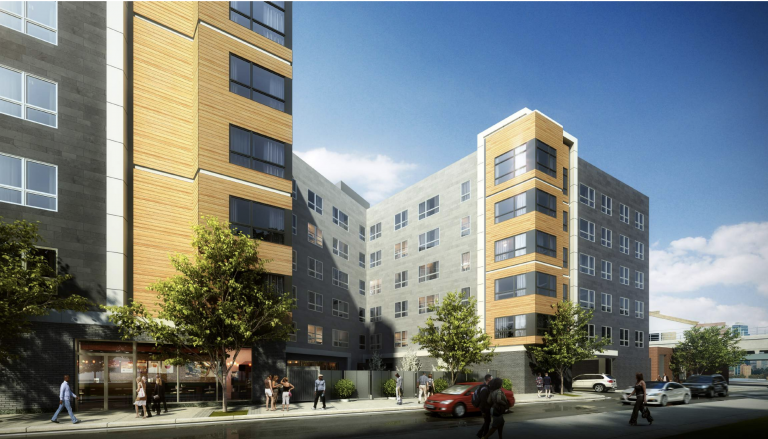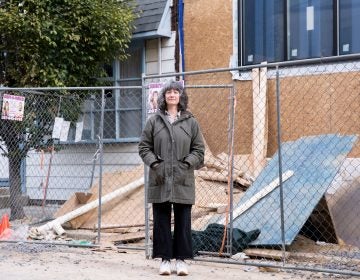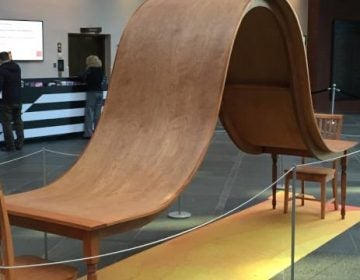Fishtown developer proposes fence; gives neighbors the ‘middle finger’
A 95-unit apartment building is coming to a blighted Fishtown lot near the Berks elevated train stop.

View of the new development from Norris Street (Coscia Moos Architecture)
This article originally appeared on PlanPhilly.
—
A 95-unit apartment building is coming to a blighted Fishtown lot near the Berks elevated train stop.
In a reprieve from Philadelphia’s toxic parking wars, neighbors aren’t worried about where residents will park — only 16 spaces are offered — but they had no kind words about a 6-foot fence that would separate the 2110 E. Norris St. development green space from the sidewalk.
At Tuesday’s Civic Design Review committee meeting, much of the city-appointed advisory panel agreed.
“The biggest thing to me when I looked at the drawings is that I don’t really understand the fence,” said Drexel University’s Nancy Rogo Trainer, chair of the CDR board. “It just seems completely anti-urban, like a middle finger to the neighborhood.”
The proposed six-story building will include commercial uses on the ground floor, a roof deck, a dog run, and a mix of mostly one-bedroom units, along with a sprinkling of studios and two-bedrooms. The developer is GY Properties, the same company that brought Cambridge Lofts to Northern Liberties and other residential retrofits to other parts to the city. The structure would lie to the east of Kensington High School’s athletic fields, but the building would front on Norris Street, where the fence would be erected.
The project’s architect, Sergio Coscia of Coscia Moos Architecture, said that his team had lowered the fence height from 10 feet to 6 feet and tweaked its angle, in response to negative feedback from the neighbors.
But Kara Haggerty Wilson of the Fishtown Neighbors Association said the 6-foot fence did not look much better.
“The neighbors thought it was a very defensive design,” said Wilson.
“We still are not sure how much you can really see through it or how close the slats are to each other. What’s the objective of it? I don’t think we ever got that answer.”
Only a third of the building’s front on Norris Street will be activated by the commercial space, drawings show. Everything else will be covered by the fence, a blank wall, or entry to the small parking garage.
The side of the building facing the football field is made of stucco. Wilson said that would present a bland perspective to thousands of people who see it from their homes to the east and commuters who skirt the field to get to the train station.
Coscia said the decision about the fence lay far beyond his control. It is simply what the client, GY Properties, required, he said. But he said it won’t be as grim and uninviting as the panel believed, partly because the renderings showing a bleak gray wall weren’t quite accurate. It would instead allow a view through the slats.
“They [GY Properties] would rather keep the courtyard private to tenants and anyone from the commercial space,” said Coscia, “which could be a coffee shop or something like that.”
The only commentator at the Civic Design Review board not objecting to the fence was Leo Addimando of Alterra Property Group.
“I applaud you for only pretending to use real wood, and instead using this plastic material that just looks like wood,” said Addimando. “There’s a whole generation of townhomes in Philadelphia that have rotting wood hanging off the side of them right now because people didn’t think through how that material painted or stained over time.”
The board did not ask the developer to come back for a second review. No zoning variances are required.
The proposed storage facility in Callowhill that the board panned at its last meeting came up for its second review. Because the CDR board enjoys no enforcement power, the developers, Johnson Development Associates and Metro Development Company, made no substantive changes to their proposal.
The project would place a six-story self-storage facility within walking distance of a Broad Street line subway stop in the midst of the burgeoning residential neighborhood of Callowhill. Located just north of Center City’s Chinatown, the area is studded with new high-rise condo and rental buildings. Community groups, Councilman Mark Squilla, and the Kenney administration have all sought to stop the development, which will create only two jobs and no housing.
But the Zoning Board of Adjustment granted the developers the variances they need. The Kenney administration is appealing the decision of the mayor-appointed body.
At this final CDR review, however, the panelists just threw up their hands in despair.
“This fails in almost every aspect of civic design,” said Daniel Garofalo, environmental sustainability director at the University of Pennsylvania and CDR member. “The design team should be ashamed to bring this before us.”
WHYY is your source for fact-based, in-depth journalism and information. As a nonprofit organization, we rely on financial support from readers like you. Please give today.







